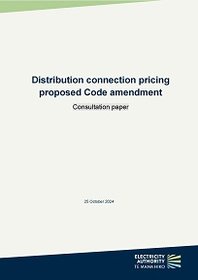Distribution connection pricing proposed Code amendment
Decision
We are progressing four of the five measures we proposed to improve pricing methodologies for connecting to the network. The four pricing methodology requirements are:
- enhancement cost allocation
- network capacity costing
- pioneer scheme
- connection charge reconciliation.
These new requirements for lines companies are a significant step towards more efficient connection pricing, making it easier for businesses and important infrastructure to get connected. They will encourage efficient investments and enable New Zealanders to enjoy the benefits of these investments sooner.
The new requirements apply to quotes for distribution network connections for load applications received from 1 April 2026. The exception is the requirement to use published rates to allocate upstream costs to access seekers as headroom is consumed. This requirement applies to quotes received on and after 1 April 2027.
The new requirements are also supported by a dispute resolution process.
In July 2025, we sought feedback on the draft wording of the new rules to ensure it accurately reflects the decisions. Following feedback, we have amended the proposed wording to better align the new Code to drafting conventions, improve clarity and remove additional or unnecessary wording. Some other amendments give clearer effect to the policy intent outlined in the decision paper.
The amendments are detailed in the addendum to the decision paper as part of the Connection pricing requirements Code amendment.
Please see our Frequently Asked Questions and this Resources section for guidance documents and other supporting material about these new requirements.
This set of new requirements is an important first step in our work to improve connection pricing methodologies.
See Distribution connection pricing reform for more information about this longer-term project.
Remaining proposals to be further considered
We have decided to further consider the remaining proposal to introduce ‘reliance limits’ to prevent already high up-front charges from increasing further.
We are also further considering the obligation on distributors to connect all applications that meet certain criteria. This obligation is part of the decisions on the related ‘Network connections project’.
More time is needed to consider these related issues, with input from the sector, to ensure any rule changes lead to the best possible long-term outcomes for all parties, including all New Zealanders.
Online Q&A sessions
We’re hosting monthly online Q&A sessions about the new rules for connection pricing methodologies that are coming into effect from April 2026. The sessions are an opportunity to ask questions about the rules and troubleshoot any implementation concerns.
Decision paper
Factsheet - summary of new requirements and modifications made to original proposals following feedback.
Webinar
We held a webinar on Friday 18 July to talk through the decisions and answer questions. The webinar also included a presentation about related decisions on distribution connection pricing.
Consultation
In late 2024, we sought feedback on a package of proposals that aim to make significant progress towards efficient connection pricing.
Making connection pricing methodologies more efficient means connection activity covers its costs while not being inefficiently deterred, and pricing encourages efficient investment in connections and upstream capacity and network development.
In recognition of the scale, complexity and impact on distributors of full reform, we are taking a phased approach to regulating efficient pricing methodologies.
Webinar
We held a webinar on Monday 11 November 2024 to talk through our proposals and answer questions. The webinar included a presentation about the related Network connections project - Stage one consultation with proposals about the application process for new and enlarged connections. Watch the webinar and read the Q&As.
Related consultation
Alongside this consultation, we welcomed feedback in the Network connections project – Stage one consultation.
This consultation ran over the same time period and aims to improve the efficiency of the application processes for connecting to the network, or upgrading an existing connection.
Together, the proposals across these consultations aim to support more efficient investment in infrastructure and businesses, and in distribution networks.
Together, the proposals across these consultations aim to support more efficient investment in infrastructure, businesses and new housing developments, and in distribution networks.
Submissions
-
Anonymous1 page
-
Aurora Energy18 pages
-
Awhitu Windfarms Ltd2 pages
-
BEC8 pages
-
Benv3 pages
-
BP NZ4 pages
-
Brodey1 page
-
Buller Electricity2 pages
-
CentrePort6 pages
-
Charge Net7 pages
-
Chris Vincent1 page
-
Contact Energy9 pages
-
Counties Energy22 pages
-
Counties Energy Trust6 pages
-
Dick Bavelaar1 page
-
Drive Electric35 pages
-
EEA2 pages
-
EECA11 pages
-
Electra4 pages
-
Electra Trust4 pages
-
ENA64 pages
-
Entrust6 pages
-
ERANZ3 pages
-
ETNZ6 pages
-
Firstlight5 pages
-
Fonterra2 pages
-
Genesis Energy4 pages
-
HBPCT1 page
-
Horizon Energy23 pages
-
Manawa Energy3 pages
-
Meridian Energy8 pages
-
MEUG5 pages
-
NEG8 pages
-
Network Waitaki15 pages
-
Northpower4 pages
-
Orion19 pages
-
Powerco27 pages
-
PowerNet8 pages
-
Rajesh K1 page
-
Rebecca Ashton1 page
-
Retyna4 pages
-
Rewiring Aotearoa2 pages
-
Robin Moore1 page
-
Ruahine Hemara1 page
-
Sara1 page
-
Scanpower Customer Trust4 pages
-
Steve Hamilton1 page
-
Tenco11 pages
-
The Lines Company4 pages
-
Transpower6 pages
-
Trust Horizon4 pages
-
UDL6 pages
-
Unison and Centralines17 pages
-
Unison and Powerco - Incenta Report21 pages
-
Vector118 pages
-
Waipa Networks12 pages
-
Waipa Networks Trust5 pages
-
Waitaki Power Trust6 pages
-
WEL Networks5 pages
-
Wellington Electricity13 pages
-
Westpower5 pages
-
West Coast Electric Power Trust4 pages
Cross-submissions
-
Buller Electricity5 pages
-
ChargeNet4 pages
-
Counties Energy3 pages
-
Counties Energy Trust7 pages
-
ENA18 pages
-
Energy Resources Aotearoa4 pages
-
ETNZ2 pages
-
Fonterra2 pages
-
Horizon Networks4 pages
-
Meridian2 pages
-
MEUG5 pages
-
Network Waitaki7 pages
-
Orion14 pages
-
Powerco11 pages
-
Unison and Centralines13 pages
-
Vector36 pages
-
Vector and HoustonKemp25 pages
-
Vector and Axiom Economics letter16 pages
-
Wellington Electricity4 pages

